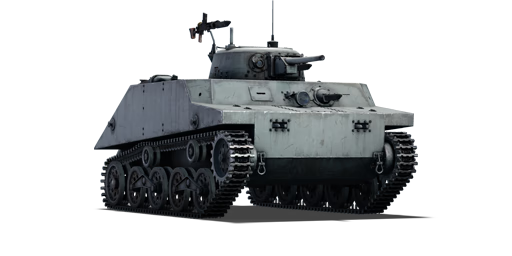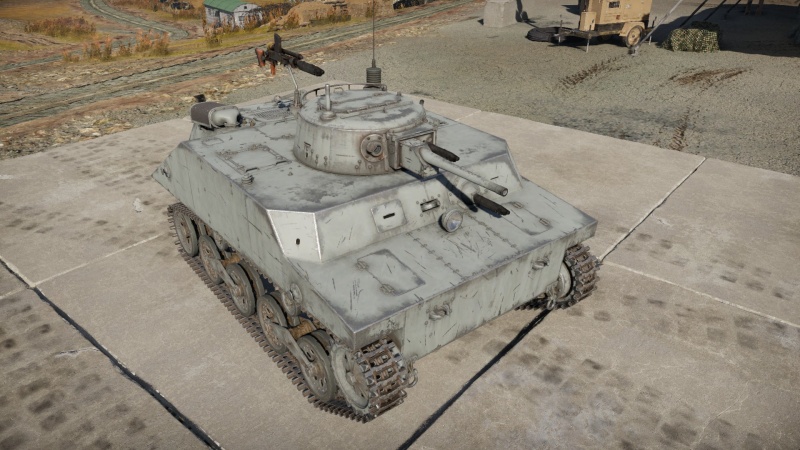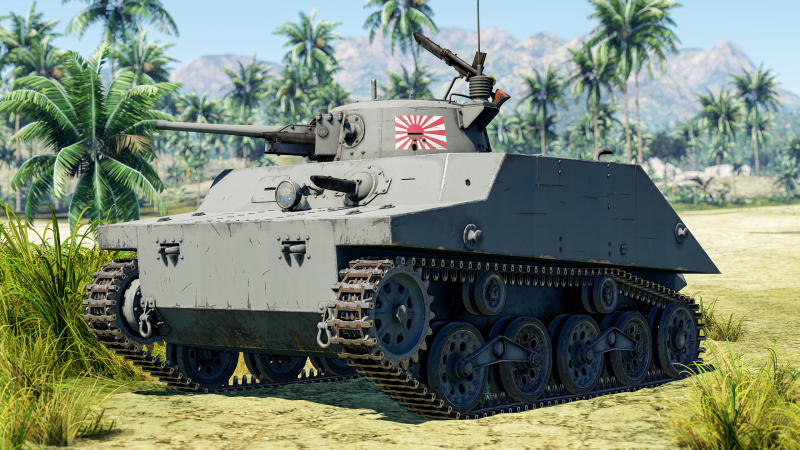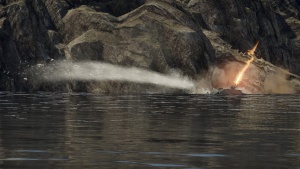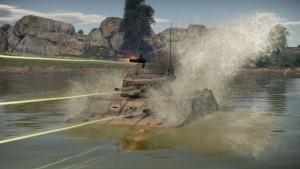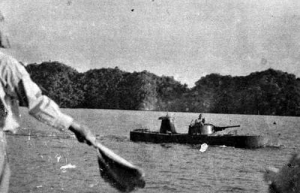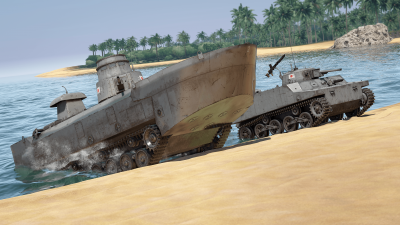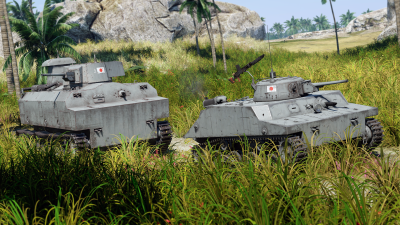Difference between revisions of "Ka-Mi"
(Edits.) |
m (→See also) |
||
| (36 intermediate revisions by 10 users not shown) | |||
| Line 1: | Line 1: | ||
| − | {{Specs-Card|code=jp_type_2_ka_mi}} | + | {{Specs-Card |
| + | |code=jp_type_2_ka_mi | ||
| + | |images={{Specs-Card-Image|GarageImage_{{PAGENAME}}.jpg|ArtImage_{{PAGENAME}}.png}} | ||
| + | }} | ||
== Description == | == Description == | ||
| − | <!--''In the description, the first part | + | <!-- ''In the description, the first part should be about the history of the creation and combat usage of the vehicle, as well as its key features. In the second part, tell the reader about the ground vehicle in the game. Insert a screenshot of the vehicle, so that if the novice player does not remember the vehicle by name, he will immediately understand what kind of vehicle the article is talking about.'' --> |
| − | + | The '''Special {{Specs|name}}''' ({{Annotation|特二式内火艇「カミ」|Toku Ni-Shiki Uchibitei [Ka-Mi]}}) was a special type light tank built by the Japanese Navy for naval landing operations. Primarily based on the [[Ha-Go]] tank, the Ka-Mi was majorly modified to be a water-tight hull allowing it to float in the water, with add-on pontoons to improve high sea traversability. | |
| − | + | ||
| − | The '''{{ | + | The Ka-Mi was introduced along with the initial Japanese Ground Forces tree in [[Update 1.65 "Way of the Samurai"]]. Unlike the Ha-Go, it features a slightly better Type 1 37 mm instead of the Type 94 37 mm and comes with a coaxial machine gun which is rather rare for WWII Japanese tanks. While the Ka-Mi doesn't receive its pontoons in-game, it still can float through the water as the propellers are mounted directly to the chassis and allows the tank crew to exploit aquatic terrain to their advantage, especially since the gun is shoulder stabilized, making it easier to aim with the waves. |
== General info == | == General info == | ||
=== Survivability and armour === | === Survivability and armour === | ||
| − | Armour | + | {{Specs-Tank-Armour}} |
| + | <!-- ''Describe armour protection. Note the most well protected and key weak areas. Appreciate the layout of modules as well as the number and location of crew members. Is the level of armour protection sufficient, is the placement of modules helpful for survival in combat? If necessary use a visual template to indicate the most secure and weak zones of the armour.'' --> | ||
| + | [[File:Ka-Mi-Cover.jpg|thumb|right|{{PAGENAME}} is best used from cover, where it can hide its massive body from enemy fire. Here: shooting from behind the hill on [[Eastern Europe (Ground Forces)|Eastern Europe]], village centre.]] | ||
| + | The Ka-Mi features a very unusual layout. Being originally designed as an amphibious tank, it is very lightly armoured. With armour thickness ranging from around 8 mm, and just reaching 12 mm on the larger portions of the hull, this tank is very fragile to anything bigger than MG fire. To increase survivability, one can enter a fight backwards in order to absorb shots with the engine, though using hard cover (such as hills and rocks) is preferable. | ||
| − | + | This armour pattern really shines at distances (500+ m), where a little angling can mostly defeat HMG fire. Since most guns at this BR are quite inaccurate, exposing only your small turret should not be a problem since it is hard to hit. If caught in an open field (still at a distance), try directly facing your foe. Angling is useless with armour so thin, meaning some shells might punch through cleanly and just fly by your crew in the uninhabited portions of the tank (ammo racks located there are pretty small, so these are often missed in such cases). | |
| − | |||
| − | This armour pattern really shines at distances (500+ m), where a little angling can mostly defeat HMG fire. Since most guns at this BR are quite inaccurate, exposing only your small turret should not be a problem since it is hard to hit. If caught in an open field ( still at | ||
| − | |||
| − | |||
| − | |||
| − | |||
| − | |||
| − | |||
'''Armour type:''' | '''Armour type:''' | ||
| Line 39: | Line 37: | ||
* Belly armour is 6 mm thick. | * Belly armour is 6 mm thick. | ||
| + | === Mobility === | ||
| + | {{Specs-Tank-Mobility}} | ||
| + | <!-- ''Write about the mobility of the ground vehicle. Estimate the specific power and manoeuvrability, as well as the maximum speed forwards and backwards.'' --> | ||
| + | [[File:Ka-Mi-Amphibious-visibility.jpg|thumb|right|{{PAGENAME}} when either firing or having its propellers on becomes an extremely visible target, even from afar. The jets of water extend over 5 times the length of the tank behind it, reaching nearly 4 times its air draft.]] | ||
| + | |||
| + | The Ka-Mi provides a decent top speed on the road but lacks such mobility when going off-road. Narrow tracks make mobility in snow/desert maps really painful. A good thing to mention: this tank has a respectable reverse speed of -11 km/h with two reverse gear, which is a rare feature at this BR. It can sometimes get you out of bad situations. | ||
| + | |||
| + | Compared to other tanks at its BR, the Ka-Mi has average mobility with no significant drawbacks, offering an ability to reach most destinations with the rest of the team, or to position for sniping or ambushes. The Ka-Mi is also somewhat prone to drifting when taking sharp turns at high speed. | ||
| + | |||
| + | The Ka-Mi travels at 10 km/h (AB/RB/SB) in water but can't propel itself backwards. Trajectory should be planned accordingly to avoid being stuck. | ||
| − | + | {{tankMobility|abMinHp=124|rbMinHp=102}} | |
| − | + | ||
| − | {| | + | === Modifications and economy === |
| − | | | + | {{Specs-Economy}} |
| − | |||
| − | |||
| − | |||
| − | |||
| − | |||
| − | |||
| − | |||
| − | |||
| − | |||
| − | |||
| − | |||
| − | |||
| − | |||
| − | |||
| − | |||
| − | |||
| − | |||
| − | |||
| − | |||
| − | |||
| − | |||
| − | |||
| − | |||
| − | |||
| − | |||
| − | |||
| − | |||
| − | |||
| − | |||
| − | |||
| − | |||
| − | |||
| − | |||
| − | |||
| − | |||
| − | |||
| − | |||
| − | |||
| − | |||
== Armaments == | == Armaments == | ||
| + | {{Specs-Tank-Armaments}} | ||
=== Main armament === | === Main armament === | ||
| − | <!--''Give the reader information about the characteristics of the main gun. Assess its effectiveness in a battle based on the reloading speed, ballistics and the power of shells. Do not forget about the | + | {{Specs-Tank-Weapon|1}} |
| + | <!-- ''Give the reader information about the characteristics of the main gun. Assess its effectiveness in a battle based on the reloading speed, ballistics and the power of shells. Do not forget about the flexibility of the fire, that is how quickly the cannon can be aimed at the target, open fire on it and aim at another enemy. Add a link to the main article on the gun: <code><nowiki>{{main|Name of the weapon}}</nowiki></code>. Describe in general terms the ammunition available for the main gun. Give advice on how to use them and how to fill the ammunition storage.'' --> | ||
{{main|Type 1 (37 mm)}} | {{main|Type 1 (37 mm)}} | ||
| − | + | The main gun of the Ka-Mi is a very basic 37 mm cannon with decent penetration and spread. A major disadvantage is its slow turn rate, making it preferable to have already aimed the turret before emerging from cover, and similarly attempting to hide it as early as possible, once the enemy emerges from a flanking direction. It does, however, feature a good depression rate, making it a potent weapon when attacking from the hills. | |
| − | + | ||
| − | + | The 37 mm is a decent gun with a good reload time and good ammo count: don't bother wasting ammo while stationary, just fire on the move. This tank has a "lock", which is a primitive form of gun stabilizer, decreasing vertical movement from the main armament - at low speeds, gun handling sees significant improvement. Note that turret rotation speed is somewhat slow: pre-aim your gun in the general direction of the enemy in close-quarter engagements. | |
| − | + | ||
| − | + | {| class="wikitable" style="text-align:center" width="100%" | |
| − | |||
| − | |||
| − | |||
| − | |||
| − | |||
| − | |||
| − | |||
| − | |||
| − | |||
| − | |||
| − | |||
| − | |||
| − | |||
| − | |||
| − | |||
| − | |||
|- | |- | ||
| − | | | + | ! colspan="5" | [[Type 1 (37 mm)|37 mm Type 1]] || colspan="5" | Turret rotation speed (°/s) || colspan="4" | Reloading rate (seconds) |
|- | |- | ||
| − | ! | + | ! Mode !! Capacity !! Vertical !! Horizontal !! Stabilizer |
| + | ! Stock !! Upgraded !! Full !! Expert !! Aced | ||
| + | ! Stock !! Full !! Expert !! Aced | ||
|- | |- | ||
| − | ! | + | ! ''Arcade'' |
| − | + | | rowspan="2" | 132 || rowspan="2" | -10°/+24° || rowspan="2" | ±180° || rowspan="2" | Vertical || 11.52 || 15.94 || 19.36 || 21.41 || 22.78 || rowspan="2" | 5.20 || rowspan="2" | 4.60 || rowspan="2" | 4.24 || rowspan="2" | 4.00 | |
| − | |||
| − | |||
|- | |- | ||
| − | | | + | ! ''Realistic'' |
| + | | 7.20 || 8.47 || 10.29 || 11.37 || 12.10 | ||
|- | |- | ||
|} | |} | ||
| − | + | ==== Ammunition ==== | |
| − | + | It's highly preferable to use the Type 1 APHE ammunition over the stock one, due to its significantly better penetration and its explosive filler. While the Type 94 shell may only damage enemy crew or components with anything barring a perfectly-placed shot, the Type 1 shell will nearly always result in an effectively destructive hit, damaging modules and crew alike. Similarly, the penetration characteristics of the Type 1 shells make all the difference between a ricochet and a successful knock-out when dealing with other tanks at this BR. | |
| − | + | ||
| − | + | {{:Type 1 (37 mm)/Ammunition|Type 94 APHE, Type 1 APHE}} | |
| − | |||
| − | |||
| − | |||
| − | |||
| − | |||
| − | |||
| − | |||
| − | |||
| − | |||
| − | |||
| − | |||
| − | |||
| − | |||
| − | |||
| − | |||
| − | |||
| − | { | ||
| − | |||
| − | |||
| − | |||
| − | |||
| − | |||
| − | |||
| − | |||
| − | |||
| − | |||
| − | |||
| − | |||
| − | |||
| − | |||
| − | |||
| − | |||
| − | |||
| − | |||
| − | |||
| − | | Type 94 APHE | ||
| − | |||
| − | |||
| − | |||
| − | |||
| − | + | ==== [[Ammo racks]] ==== | |
| − | [[File:Ammoracks_{{PAGENAME}}.png|right|x250px | + | [[File:Ammoracks_{{PAGENAME}}.png|right|thumb|x250px|[[Ammo racks]] of the {{PAGENAME}}]] |
| − | {| class="wikitable | + | <!-- '''Last updated: 1.101.0.44''' --> |
| + | {| class="wikitable" style="text-align:center" | ||
|- | |- | ||
| − | ! | + | ! Full<br>ammo |
| − | ! | + | ! 1st<br>rack empty |
| − | ! | + | ! 2nd<br>rack empty |
| − | ! | + | ! 3rd<br>rack empty |
| − | ! | + | ! Visual<br>discrepancy |
|- | |- | ||
| − | + | | '''132''' || 73 ''(+59)'' || 25 ''(+107)'' || 1 ''(+131)'' || No | |
|- | |- | ||
|} | |} | ||
| − | 73 | + | Due to a high maximum ammo capacity, leaving at least the first ammo rack empty could be preferred in order to reduce the chance of enemy shots causing any ammo detonation. This can be done by only carrying 73 or fewer shells. Furthermore, when angling the tank to the enemy, it's preferred to expose the left side to the enemy, rather than the right one, which will always contain a loaded ammunition rack. To prevent crew members from being knocked out, the right side should be protected whenever possible. |
=== Machine guns === | === Machine guns === | ||
| − | <!--''Offensive and anti-aircraft machine guns not only allow you to fight some aircraft | + | {{Specs-Tank-Weapon|2}} |
| − | {{main|Type 97 | + | {{Specs-Tank-Weapon|3}} |
| + | <!-- ''Offensive and anti-aircraft machine guns not only allow you to fight some aircraft but also are effective against lightly armoured vehicles. Evaluate machine guns and give recommendations on its use.'' --> | ||
| + | [[File:Ka-Mi-Machine-Guns.jpg|thumb|right|All three machine guns visible. From top: exposed pintle mount, coaxial next to the main gun and hull mount]] | ||
| + | {{main|Type 97 (7.7 mm)}} | ||
| + | One thing that saves the Ka-Mi's reputation is its MG count: there are 3 of them. One is coaxial, fired by the gunner, another is pintle-mounted, also fired by the gunner, and the last is hull-mounted, fired by the machine gunner. These weapons have good burst capabilities that can take out lightly-armoured targets (Soviet SPAA trucks, open-topped SPGs, etc.). This also allows the Ka-Mi to become an unlikely SPAA, armed with three machine guns and a cannon. It can quite easily damage low-flying biplanes, although sustained hits are still required to successfully down an aircraft. One downside of the [[Type 97 tank (7.7 mm)|Type 97]] machine gun is its low ammo count, which limits bursts to a couple of seconds before having to reload. Reloads, fortunately, don't take long. | ||
| − | {| class="wikitable" style="text-align:center | + | The {{PAGENAME}} has a rare setup for its BR, featuring a group of three 7.7 mm MGs that allow it to quickly dispose of enemy lightly-armoured vehicles, especially rank I SPAAGs. The MGs are supplied with limited ammo capacity, allowing for a short bursts before reloading. In effect, shorter bursts into different portions of the enemy vehicle are recommended over lengthy bursts to gradually disable modules and crew members. |
| − | + | ||
| − | + | {| class="wikitable" style="text-align:center" width="50%" | |
| − | |||
| − | |||
| − | |||
| − | |||
| − | |||
| − | |||
| − | |||
|- | |- | ||
| − | + | ! colspan="5" | [[Type 97 (7.7 mm)|7.7 mm Type 97]] | |
|- | |- | ||
| − | ! | + | ! Mount !! Capacity (Belt) !! Fire rate !! Vertical !! Horizontal |
|- | |- | ||
| − | + | | Coaxial || 4,000 (20) || 499 || N/A || N/A | |
| − | |||
| − | |||
| − | |||
|- | |- | ||
| − | | | + | | Hull || 3,000 (20) || 499 || -11°/+35° || ±20° |
|- | |- | ||
| − | + | | Pintle || 1,000 (20) || 499 || -10°/+70° || ±60° | |
| − | | | ||
| − | |||
| − | |||
| − | |||
| − | |||
| − | |||
| − | |||
|- | |- | ||
|} | |} | ||
| − | == Usage in | + | == Usage in battles == |
| − | <!--''Describe the tactics of playing in the vehicle, the features of using vehicles in the team and advice on tactics. Refrain from creating a "guide" - do not impose a single point of view but give the reader food for thought. Describe the most dangerous enemies and give recommendations on fighting them. If necessary, note the specifics of the game in different modes (AB, RB, SB).''--> | + | <!-- ''Describe the tactics of playing in the vehicle, the features of using vehicles in the team and advice on tactics. Refrain from creating a "guide" - do not impose a single point of view but instead give the reader food for thought. Describe the most dangerous enemies and give recommendations on fighting them. If necessary, note the specifics of the game in different modes (AB, RB, SB).'' --> |
| − | With its average armour, firepower and mobility, the Ka-Mi should be played wisely, with a bit of finesse: you will not survive frontal engagement, neither can you flank nor snipe.. | + | With its average armour, firepower and mobility, the Ka-Mi should be played wisely, with a bit of finesse: you will not survive frontal engagement, neither can you flank nor snipe. This leaves you the support role. Always play as a team when driving the Ka-Mi, bringing an additional potent close-range gun to the fight, threatening your foes while more potent allies reload. |
| − | Use hills to your advantage, fall back when outnumbered and beware difficult terrain since it can slow down your manoeuvres. | + | Use hills to your advantage, fall back when outnumbered and beware difficult terrain since it can slow down your manoeuvres significantly. Do not rely on the armour as even with angling, its effective protection is nearly always penetrable by enemy tanks. |
| − | === | + | === Pros and cons === |
| − | + | <!-- ''Summarise and briefly evaluate the vehicle in terms of its characteristics and combat effectiveness. Mark its pros and cons in a bulleted list. Try not to use more than 6 points for each of the characteristics. Avoid using categorical definitions such as "bad", "good" and the like - use substitutions with softer forms such as "inadequate" and "effective".'' --> | |
| − | |||
| − | |||
| − | |||
| − | |||
| − | |||
| − | |||
| − | |||
| − | |||
| − | |||
| − | |||
| − | |||
| − | |||
| − | |||
| − | |||
| − | |||
| − | |||
| − | |||
| − | |||
| − | |||
| − | |||
| − | |||
| − | |||
| − | |||
| − | |||
| − | |||
| − | |||
| − | |||
| − | |||
| − | |||
| − | |||
| − | |||
| − | |||
| − | |||
| − | |||
| − | + | '''Pros:''' | |
| − | |||
| − | '''Pros''' | ||
* 37 mm gun has decent post-penetration damage | * 37 mm gun has decent post-penetration damage | ||
* Has a lot of machine guns, allowing a mediocre amphibious tank to turn into an impromptu SPAA instantly | * Has a lot of machine guns, allowing a mediocre amphibious tank to turn into an impromptu SPAA instantly | ||
| − | * Tiny turret. Hard to target it at the range | + | * Tiny turret. Hard to target it at the range |
* High ammo count (both cannon and MG) | * High ammo count (both cannon and MG) | ||
* 10° gun depression | * 10° gun depression | ||
* Decent reverse speed (-11 km/h) | * Decent reverse speed (-11 km/h) | ||
| − | * Has a coaxial machine gun, unlike most low | + | * Has a coaxial machine gun, unlike most low rank Japanese tanks |
| + | * Amphibious design will float on water | ||
| − | '''Cons''' | + | '''Cons:''' |
* 37 mm penetration value starting to feel lacking | * 37 mm penetration value starting to feel lacking | ||
* Hull size is wider than other Japanese light tanks | * Hull size is wider than other Japanese light tanks | ||
* Hull front plate is thin and relatively unsloped | * Hull front plate is thin and relatively unsloped | ||
| − | |||
* Tiny turret, big hull. People with have no trouble targeting you | * Tiny turret, big hull. People with have no trouble targeting you | ||
* Only two ammo choice, both APHE, one is clearly superior over the other | * Only two ammo choice, both APHE, one is clearly superior over the other | ||
| Line 291: | Line 159: | ||
== History == | == History == | ||
| − | <!--''Describe the history of the creation and combat usage of the | + | <!-- ''Describe the history of the creation and combat usage of the vehicle in more detail than in the introduction. If the historical reference turns out to be too long, take it to a separate article, taking a link to the article about the vehicle and adding a block "/History" (example: <nowiki>https://wiki.warthunder.com/(Vehicle-name)/History</nowiki>) and add a link to it here using the <code>main</code> template. Be sure to reference text and sources by using <code><nowiki><ref></ref></nowiki></code>, as well as adding them at the end of the article with <code><nowiki><references /></nowiki></code>. This section may also include the vehicle's dev blog entry (if applicable) and the in-game encyclopedia description (under <code><nowiki>=== In-game description ===</nowiki></code>, also if applicable).'' --> |
===Development=== | ===Development=== | ||
| − | While | + | [[File:Ka-Mi Captured Rabaul.jpg|thumb|A couple of captured Ka-Mi's with their pontoons deattached for land usage. Rabaul, 1945]] |
| + | While tanks were used mainly in the Imperial Japanese Army (IJA), the Imperial Japanese Navy (IJN) also owned their own land forces known as the Special Naval Landings Forces (SNLF). Their standard tanks was the [[Ha-Go|Type 95 Ha-Go]], but the SNLF wanted a more capable tank fitted for amphibious landings. The Japanese have touched upon the amphibious tank concept since the 1930s, but one built to withstand rough seas needed more durability than one designed for rivers and more calm waters. The IJN approached Mitsubishi in 1941 to develop the new amphibious tank, named '''Ka-Mi''' "Special Craft". The tank was to go along with the IJA's Type 2 Ke-To light tank, using a similar turret design. The suspension of the vehicle was one derived from the Ha-Go. The amphibious capability was given to the tank via two removable pontoons on the front and back of the tank. A trunk and a tower were fitted over the engine and turret respectively to prevent water from flowing into the engine and crew compartment. The vehicle, accepted as the '''Type 2 Ka-Mi''', began production in 1943. Up to 182 tanks were produced by the end of the war, mostly supporting Japanese positions in Saipan and the Philippines.<ref name="ZalogaJapaneseTank">Zaloga Steven. ''Japanese Tanks 1939-1945'' Great Britain: Osprey Publishing Ltd., 2007</ref> | ||
===Combat Usage=== | ===Combat Usage=== | ||
| − | The Type 2 Ka-Mi saw | + | [[File:Ka-Mi sailing.png|thumb|left|A '''Type 2 Ka-Mi''' sailing through the waters of occupied Dutch East Indies]] |
| + | The Type 2 Ka-Mi saw combat in 1944 in Saipan and Leyte.<ref name="ZalogaJapaneseTank" /> They assisted the stationed SNLF units on these islands in attacking the American beachheads via amphibious assaults. The Ka-Mi were also stationed in Luzon, and a handful were captured by Allied forces in 1945. Their limited numbers and usage meant they fought with relative obscurity to the IJA's [[Chi-Ha Kai|Type 97 Chi-Ha]] tanks. However, the Type 2 Ka-Mi was deemed rather successful by the IJN. Some have dubbed it the "best-designed amphibious tank of the war" after the conclusion of World War II. This led to successors like the [[Ka-Chi|Type 3 Ka-Chi]], a parallel to the [[Chi-He|Type 1 Chi-He]], and the Type 5 To-Ku, based on the [[Chi-Ri II|Type 5 Chi-Ri]]. | ||
| + | {{break}} | ||
== Media == | == Media == | ||
| − | '' | + | <!-- ''Excellent additions to the article would be video guides, screenshots from the game, and photos.'' --> |
| − | == | + | ;Skins |
| − | < | + | * [https://live.warthunder.com/feed/camouflages/?vehicle=jp_type_2_ka_mi Skins and camouflages for the {{PAGENAME}} from live.warthunder.com.] |
| + | |||
| + | ;Images | ||
| + | <gallery mode="packed-hover" heights="150px"> | ||
| + | Ka-Chi (2).png|Type 3 Ka-Chi & Type 2 Ka-Mi landing ashore | ||
| + | Ka-Chi (1).png|Type 3 Ka-Chi & Type 2 Ka-Mi driving across land | ||
| + | ArtImage Ka-Mi.png|Ka-Mi driving across Jungle | ||
| + | Type 2 ka mi 02.jpg|Ka-Mi promotional image showing front of the hull and size with a human to scale | ||
| + | Type 2 ka mi 04.jpg|Rear of the vehicle on another promo image | ||
| + | </gallery> | ||
| − | == | + | == See also == |
| + | <!--''Links to the articles on the War Thunder Wiki that you think will be useful for the reader, for example:'' | ||
| + | * ''reference to the series of the vehicles;'' | ||
| + | * ''links to approximate analogues of other nations and research trees.''--> | ||
| + | ;Related Development | ||
| + | * [[Ha-Go (Family)|Type 95 Ha-Go]] (Based off) | ||
| + | * [[Ka-Chi|Type 3 Ka-Chi]] (Successor) | ||
| − | * [ | + | ;Tanks of comparable role, configuration, and era |
| + | * [[File:USA flag.png|30px|link=]] [[LVT(A)(1)]] | ||
| − | == | + | == External links == |
| − | <!--''Paste links to sources and external resources, such as:'' | + | <!-- ''Paste links to sources and external resources, such as:'' |
* ''topic on the official game forum;'' | * ''topic on the official game forum;'' | ||
| − | * ''other literature.''--> | + | * ''other literature.'' --> |
| + | |||
| + | * [[wt:en/news/4328-development-type-2-ka-mi-beach-patrol-en/|[Devblog] Type 2 Ka-Mi: Beach Patrol]] | ||
| + | |||
| + | ===References=== | ||
| + | <references /> | ||
| + | {{ShipManufacturer Yokosuka Naval Arsenal}} | ||
{{Japan light tanks}} | {{Japan light tanks}} | ||
Latest revision as of 23:50, 25 June 2024
Contents
Description
The Special Type 2 Ka-Mi (特二式内火艇「カミ」) was a special type light tank built by the Japanese Navy for naval landing operations. Primarily based on the Ha-Go tank, the Ka-Mi was majorly modified to be a water-tight hull allowing it to float in the water, with add-on pontoons to improve high sea traversability.
The Ka-Mi was introduced along with the initial Japanese Ground Forces tree in Update 1.65 "Way of the Samurai". Unlike the Ha-Go, it features a slightly better Type 1 37 mm instead of the Type 94 37 mm and comes with a coaxial machine gun which is rather rare for WWII Japanese tanks. While the Ka-Mi doesn't receive its pontoons in-game, it still can float through the water as the propellers are mounted directly to the chassis and allows the tank crew to exploit aquatic terrain to their advantage, especially since the gun is shoulder stabilized, making it easier to aim with the waves.
General info
Survivability and armour
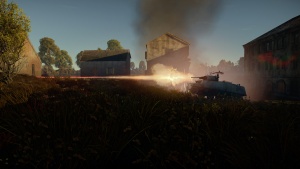
The Ka-Mi features a very unusual layout. Being originally designed as an amphibious tank, it is very lightly armoured. With armour thickness ranging from around 8 mm, and just reaching 12 mm on the larger portions of the hull, this tank is very fragile to anything bigger than MG fire. To increase survivability, one can enter a fight backwards in order to absorb shots with the engine, though using hard cover (such as hills and rocks) is preferable.
This armour pattern really shines at distances (500+ m), where a little angling can mostly defeat HMG fire. Since most guns at this BR are quite inaccurate, exposing only your small turret should not be a problem since it is hard to hit. If caught in an open field (still at a distance), try directly facing your foe. Angling is useless with armour so thin, meaning some shells might punch through cleanly and just fly by your crew in the uninhabited portions of the tank (ammo racks located there are pretty small, so these are often missed in such cases).
Armour type:
- Rolled homogeneous armour
| Armour | Front | Sides | Rear | Roof |
|---|---|---|---|---|
| Hull | 12 mm (30°) Front plate 6 mm (83°) Front glacis 12 mm (4-39°) Lower glacis |
10 mm | 10 mm (12°) Middle 12 mm (59°) Side |
6 mm |
| Turret | 12 mm (0-8°) Turret front 30 mm Gun mantlet |
12 mm (10-12°) | 12 mm (12-13°) | 6 mm |
Notes
- Suspension wheels and tracks are both 15 mm thick.
- Belly armour is 6 mm thick.
Mobility
The Ka-Mi provides a decent top speed on the road but lacks such mobility when going off-road. Narrow tracks make mobility in snow/desert maps really painful. A good thing to mention: this tank has a respectable reverse speed of -11 km/h with two reverse gear, which is a rare feature at this BR. It can sometimes get you out of bad situations.
Compared to other tanks at its BR, the Ka-Mi has average mobility with no significant drawbacks, offering an ability to reach most destinations with the rest of the team, or to position for sniping or ambushes. The Ka-Mi is also somewhat prone to drifting when taking sharp turns at high speed.
The Ka-Mi travels at 10 km/h (AB/RB/SB) in water but can't propel itself backwards. Trajectory should be planned accordingly to avoid being stuck.
| Game Mode | Max Speed (km/h) | Weight (tons) | Engine power (horsepower) | Power-to-weight ratio (hp/ton) | |||
|---|---|---|---|---|---|---|---|
| Forward | Reverse | Stock | Upgraded | Stock | Upgraded | ||
| Arcade | Expression error: Unexpected * operator. | 124 | Expression error: Unexpected round operator. | __.__ | |||
| Realistic | 102 | Expression error: Unexpected round operator. | __.__ | ||||
Modifications and economy
Armaments
Main armament
The main gun of the Ka-Mi is a very basic 37 mm cannon with decent penetration and spread. A major disadvantage is its slow turn rate, making it preferable to have already aimed the turret before emerging from cover, and similarly attempting to hide it as early as possible, once the enemy emerges from a flanking direction. It does, however, feature a good depression rate, making it a potent weapon when attacking from the hills.
The 37 mm is a decent gun with a good reload time and good ammo count: don't bother wasting ammo while stationary, just fire on the move. This tank has a "lock", which is a primitive form of gun stabilizer, decreasing vertical movement from the main armament - at low speeds, gun handling sees significant improvement. Note that turret rotation speed is somewhat slow: pre-aim your gun in the general direction of the enemy in close-quarter engagements.
| 37 mm Type 1 | Turret rotation speed (°/s) | Reloading rate (seconds) | |||||||||||
|---|---|---|---|---|---|---|---|---|---|---|---|---|---|
| Mode | Capacity | Vertical | Horizontal | Stabilizer | Stock | Upgraded | Full | Expert | Aced | Stock | Full | Expert | Aced |
| Arcade | 132 | -10°/+24° | ±180° | Vertical | 11.52 | 15.94 | 19.36 | 21.41 | 22.78 | 5.20 | 4.60 | 4.24 | 4.00 |
| Realistic | 7.20 | 8.47 | 10.29 | 11.37 | 12.10 | ||||||||
Ammunition
It's highly preferable to use the Type 1 APHE ammunition over the stock one, due to its significantly better penetration and its explosive filler. While the Type 94 shell may only damage enemy crew or components with anything barring a perfectly-placed shot, the Type 1 shell will nearly always result in an effectively destructive hit, damaging modules and crew alike. Similarly, the penetration characteristics of the Type 1 shells make all the difference between a ricochet and a successful knock-out when dealing with other tanks at this BR.
| Penetration statistics | |||||||
|---|---|---|---|---|---|---|---|
| Ammunition | Type of warhead |
Penetration @ 0° Angle of Attack (mm) | |||||
| 10 m | 100 m | 500 m | 1,000 m | 1,500 m | 2,000 m | ||
| Type 94 APHE | APHE | 46 | 44 | 36 | 29 | 23 | 18 |
| Type 1 APHE | APHE | 57 | 54 | 39 | 26 | 18 | 12 |
| Shell details | ||||||||||||
|---|---|---|---|---|---|---|---|---|---|---|---|---|
| Ammunition | Type of warhead |
Velocity (m/s) |
Projectile mass (kg) |
Fuse delay (m) |
Fuse sensitivity (mm) |
Explosive mass (TNT equivalent) (g) |
Ricochet | |||||
| 0% | 50% | 100% | ||||||||||
| Type 94 APHE | APHE | 700 | 0.7 | 1.2 | 9 | 11 | 47° | 60° | 65° | |||
| Type 1 APHE | APHE | 800 | 0.72 | 1.2 | 9 | 12.8 | 47° | 60° | 65° | |||
Ammo racks
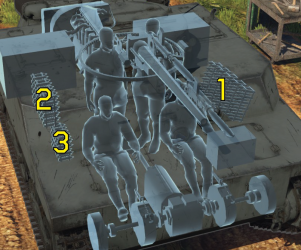
| Full ammo |
1st rack empty |
2nd rack empty |
3rd rack empty |
Visual discrepancy |
|---|---|---|---|---|
| 132 | 73 (+59) | 25 (+107) | 1 (+131) | No |
Due to a high maximum ammo capacity, leaving at least the first ammo rack empty could be preferred in order to reduce the chance of enemy shots causing any ammo detonation. This can be done by only carrying 73 or fewer shells. Furthermore, when angling the tank to the enemy, it's preferred to expose the left side to the enemy, rather than the right one, which will always contain a loaded ammunition rack. To prevent crew members from being knocked out, the right side should be protected whenever possible.
Machine guns
One thing that saves the Ka-Mi's reputation is its MG count: there are 3 of them. One is coaxial, fired by the gunner, another is pintle-mounted, also fired by the gunner, and the last is hull-mounted, fired by the machine gunner. These weapons have good burst capabilities that can take out lightly-armoured targets (Soviet SPAA trucks, open-topped SPGs, etc.). This also allows the Ka-Mi to become an unlikely SPAA, armed with three machine guns and a cannon. It can quite easily damage low-flying biplanes, although sustained hits are still required to successfully down an aircraft. One downside of the Type 97 machine gun is its low ammo count, which limits bursts to a couple of seconds before having to reload. Reloads, fortunately, don't take long.
The Ka-Mi has a rare setup for its BR, featuring a group of three 7.7 mm MGs that allow it to quickly dispose of enemy lightly-armoured vehicles, especially rank I SPAAGs. The MGs are supplied with limited ammo capacity, allowing for a short bursts before reloading. In effect, shorter bursts into different portions of the enemy vehicle are recommended over lengthy bursts to gradually disable modules and crew members.
| 7.7 mm Type 97 | ||||
|---|---|---|---|---|
| Mount | Capacity (Belt) | Fire rate | Vertical | Horizontal |
| Coaxial | 4,000 (20) | 499 | N/A | N/A |
| Hull | 3,000 (20) | 499 | -11°/+35° | ±20° |
| Pintle | 1,000 (20) | 499 | -10°/+70° | ±60° |
Usage in battles
With its average armour, firepower and mobility, the Ka-Mi should be played wisely, with a bit of finesse: you will not survive frontal engagement, neither can you flank nor snipe. This leaves you the support role. Always play as a team when driving the Ka-Mi, bringing an additional potent close-range gun to the fight, threatening your foes while more potent allies reload.
Use hills to your advantage, fall back when outnumbered and beware difficult terrain since it can slow down your manoeuvres significantly. Do not rely on the armour as even with angling, its effective protection is nearly always penetrable by enemy tanks.
Pros and cons
Pros:
- 37 mm gun has decent post-penetration damage
- Has a lot of machine guns, allowing a mediocre amphibious tank to turn into an impromptu SPAA instantly
- Tiny turret. Hard to target it at the range
- High ammo count (both cannon and MG)
- 10° gun depression
- Decent reverse speed (-11 km/h)
- Has a coaxial machine gun, unlike most low rank Japanese tanks
- Amphibious design will float on water
Cons:
- 37 mm penetration value starting to feel lacking
- Hull size is wider than other Japanese light tanks
- Hull front plate is thin and relatively unsloped
- Tiny turret, big hull. People with have no trouble targeting you
- Only two ammo choice, both APHE, one is clearly superior over the other
- Narrow tracks means poor off-road mobility
- Low engine HP makes hill-climbing only possible at low gear, which even then is difficult
- Weak armour makes you an easy target for aircraft with high penetration on their guns
History
Development
While tanks were used mainly in the Imperial Japanese Army (IJA), the Imperial Japanese Navy (IJN) also owned their own land forces known as the Special Naval Landings Forces (SNLF). Their standard tanks was the Type 95 Ha-Go, but the SNLF wanted a more capable tank fitted for amphibious landings. The Japanese have touched upon the amphibious tank concept since the 1930s, but one built to withstand rough seas needed more durability than one designed for rivers and more calm waters. The IJN approached Mitsubishi in 1941 to develop the new amphibious tank, named Ka-Mi "Special Craft". The tank was to go along with the IJA's Type 2 Ke-To light tank, using a similar turret design. The suspension of the vehicle was one derived from the Ha-Go. The amphibious capability was given to the tank via two removable pontoons on the front and back of the tank. A trunk and a tower were fitted over the engine and turret respectively to prevent water from flowing into the engine and crew compartment. The vehicle, accepted as the Type 2 Ka-Mi, began production in 1943. Up to 182 tanks were produced by the end of the war, mostly supporting Japanese positions in Saipan and the Philippines.[1]
Combat Usage
The Type 2 Ka-Mi saw combat in 1944 in Saipan and Leyte.[1] They assisted the stationed SNLF units on these islands in attacking the American beachheads via amphibious assaults. The Ka-Mi were also stationed in Luzon, and a handful were captured by Allied forces in 1945. Their limited numbers and usage meant they fought with relative obscurity to the IJA's Type 97 Chi-Ha tanks. However, the Type 2 Ka-Mi was deemed rather successful by the IJN. Some have dubbed it the "best-designed amphibious tank of the war" after the conclusion of World War II. This led to successors like the Type 3 Ka-Chi, a parallel to the Type 1 Chi-He, and the Type 5 To-Ku, based on the Type 5 Chi-Ri.
Media
- Skins
- Images
See also
- Related Development
- Type 95 Ha-Go (Based off)
- Type 3 Ka-Chi (Successor)
- Tanks of comparable role, configuration, and era
External links
References
| Yokosuka Naval Arsenal (横須賀海軍工廠) | |
|---|---|
| Destroyers (DD) | |
| Momi-class | IJN Momi |
| Light Cruisers (CL) | |
| Mogami-class | IJN Suzuya |
| Heavy Cruisers (CA) | |
| Myōkō-class | IJN Myoko |
| Battlecruisers (BC) | |
| Kurama-class | IJN Kurama |
| Amagi-class | IJN Amagi |
| Battleships (BB) | |
| Fusō-class | IJN Yamashiro |
| Nagato-class | IJN Mutsu |
| Tanks | Ka-Mi · Ka-Chi · Chi-Ha LG |
| See also | Yokosuka Naval Air Technical Arsenal |
| Japan light tanks | |
|---|---|
| Type 89 | I-Go Ko |
| Type 95 | Ha-Go · Ha-Go Commander |
| Type 98 | Ke-Ni |
| Other | Ka-Mi |
| IFV | Type 89 |
| RCV | Type 87 RCV (P) · Type 87 RCV · RCV (P) |
| MCV | Type 16 (P) · Type 16 (FPS) · Type 16 |
| USA | ▅M24 · ▅M41A1 |


